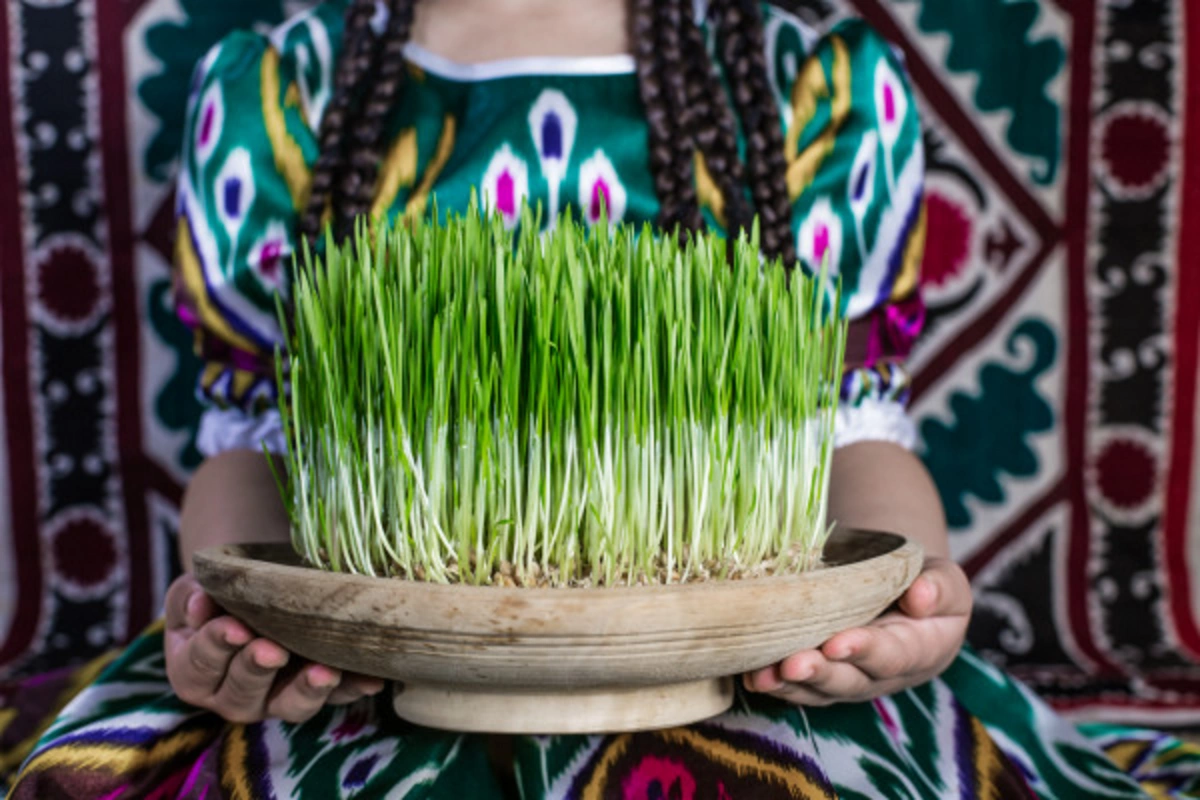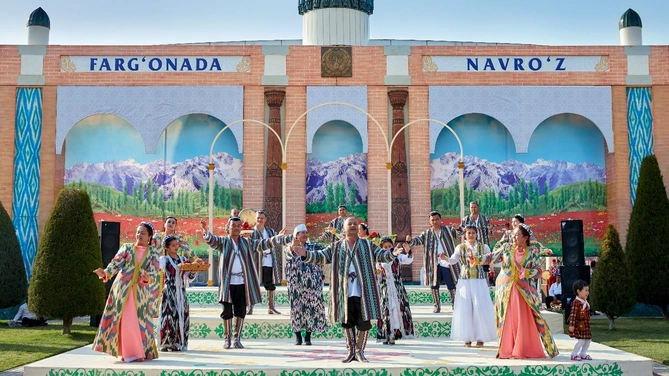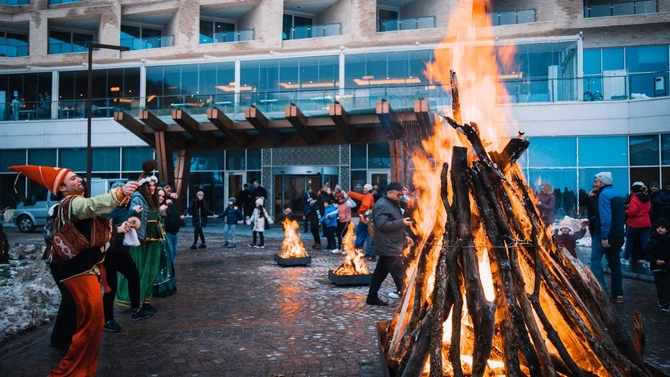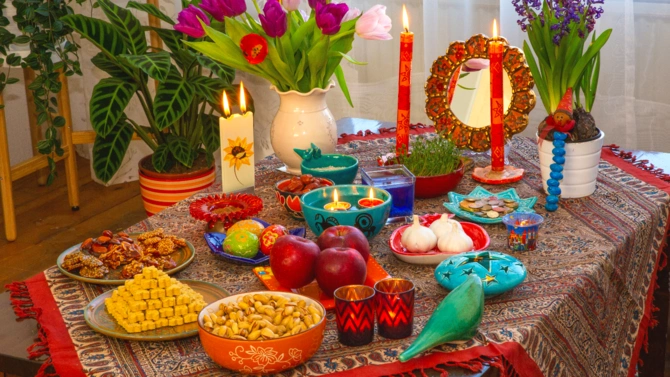
Call it Novruz, Nowruz, Nooruz, Nauryz or Navruz, the spring equinox festival is the most significant holiday period for Iran, Azerbaijan and many people in Central Asia. However, the associated customs vary considerably between countries and regions.
A plate of wheatgrass is a shared tradition across the Caspian region when it comes to celebrating the spring equinox holiday of Novruz/Nowruz. Image: Alisher Primkulov/Shutterstock
For a tourist arriving in Azerbaijan during the latter part of March, the country looks it's merry best. Spring is beginning to wield its emerald brush across the arable lowlands, while in towns and cities, you’ll find an array of public festivities and family celebrations. Contrastingly, it’s a terrible time for a business trip with most government offices closed for days on end. Somewhat equivalent in scale to Christmas time in Western Europe, this is ‘Novruz’ - the country’s single biggest holiday season. But by no means is it limited to Azerbaijan. The term comes from a Farsi phrase meaning “new day,” and the festival marks the start of the new year in the Persian calendar. So unsurprisingly, the celebration is particularly important in Iran, the season stretching out nearly two weeks. In Central Asia, thought shorter, the festival is a highlight of the year for many people, whether spelled Navruz (Uzbekistan, Tajikistan), Nauryz (Kazakhstan), Nooruz (Kyrgyzstan) or Nowruz (Turkmenistan as in Iran). Since 2016, Novruz – by any of its many spellings and manifestations – was inscribed on UNESCO’s Representative List of the Intangible Cultural Heritage of Humanity, and March 21 has been recognized by the general assembly as the International Day of Nowruz.

The holiday is by no means limited to Azerbaijan and Iran. In Central Asia they celebrate Navruz in Uzbekistan (pictured) and Tajikistan, Nauryz in Kazakhstan, Nooruz in Kyrgyzstan and Nowruz in Turkmenistan. Image: RelisaGranovskaya/Shutterstock
Almost by definition, folk culture


In all celebrating countries, you’ll find a mixture of contemporary and traditional performances, games, sports and public entertainment. In some, street theatre features a clown-like gift-giving figure and/or a black-faced bully vaguely reminiscent of St Nicholas/Santa and Zwarte Piet in north European pre-Christmas traditions. In Iran, the two are rolled into one as Haji Piruz, leading to questions of racial insensitivity. In Azerbaijan, the pointy-hatted figure of Kosa and his jovial retinue Kechel are more common. A high


In Azerbaijan, the pointy hatted Kosa and bald Kechel are featured prominently in Novruz folklore. Leaping over bonfires is used as a way to symbolize a spirit of "out with the old and in with the new," leaving last year behind and embracing the next. Image: Elshad Aliyev/Shutterstock
Another distinctive Nowruz/Novruz tradition in Azerbaijan and Iran that has largely died out in Central Asia is that of the four cha(har)shanbe “Wednesdays” before March 21. The most notable feature is ‘fire-jumping’ on the Tuesday night before the last of these, though you might also find that happening in Azerbaijan on the three other such Tuesdays before Novruz.
Almost everything about Nowruz/Novruz is dripping with symbolism about rebirth, new life and respect for the natural cycle of existence. Perhaps the most ubiquitous and easily understood symbol of such regeneration is that of germinating wheatgrass. Known as sabzeh in Iran and səməni/samani in Azerbaijan, a plate of such grains is planted such that it will have become a vivid green mass of grass shoots by the time Nowruz/Novruz arrives. Often this is presented ringed by a band of red ribbon and, in Azerbaijan, there might also be a boncuk or göz (blue and white ‘eye’ bead to ward off evil spirits) attached. You’ll find samani grass as a recognizable icon on many a Novruz/Nowruz greeting and in virtually every building, whether grown at home or – as is increasingly common these days – purchased ready-sprouted from a grocery store.
The tradition of growing and displaying wheatgrass is less common in Central Asia – though you might see it in southern Kyrgyzstan. What is far more common is to use the same germinating grains to make a laboriously long-boiled viscous pudding called samanoo in Iran or sumalak/sumolok/sumanak in Uzbekistan/Kyrgyzstan/Tajikistan. At Central Asian Navruz/Nooruz/Nowruz, cauldrons of the stuff are made with great ritual care, often on public squares, with families displaying mutual respect by each contributing grains to the pot and taking turns to keep stirring it all night long.
In Iran, the lead-up to Nowruz sees virtually every home and business put out a beautifully arranged display of seven symbolically relevant items. These are known collectively as the

Almost inevitably the seven will include both the sabzeh and samanoo mentioned above. The other five items are traditionally seeb (apples, symbolizing beauty), seer (garlic, symbolizing health), serkeh (vinegar, symbolizing patience), senjed (a mealy date-like fruit with anti-arthritic properties) and sumac (a type of spice). Possible alternative ‘s’ items can include sekkeh (coins) and sonbol (hyacinths) while it’s increasingly common to find non ‘s’ additions with fairly obvious symbolism – a mirror (for self-reflection), eggs (painted in Russian Easter style), candles and a goldfish in a bowl. Finally, according to one’s faith, it’s likely that there will also be a holy or inspirational book – generally the Koran as a nod to contemporary Islamic mores.

The Nowruz table in Iran is laid out with seven symbolically relevant items - all starting with the letter S. Image: Youshij Yousefzadeh/Shutterstock
Such symbolic ‘holiday tables’ are less widespread in Central Asia, but when laid, the guide letter for the seven items is typically a ‘sh.’ So a typical array could include shakar (sugar), sham (candle), sharbat (sherbet), sharob (wine), shir (milk), shirinliklar (sweets) and shona (the bud of a soon-to-blossom tree). In Kazakhstan, the seven-element theme is applied to the ingredients of a special festive drink called Nauryz kozhe.
In Azerbaijan, the Novruz host is relatively free to extemporize using a khoncha (xonça) tray or table generously overloaded with a series of snacks, sweets, nuts and dried fruits ranged around a plate of samani. The three most archetypal delicacies on such an Azerbaijani holiday table have a certain celestial resonance due to their shapes: diamonds of pakhlava (a syrup-moistened layered confection) being typically arranged into a star-shaped pattern), along with round ‘sun-shaped’ goghal (semi-sweet puffs yellowed with turmeric) and half-moon shekerbura (dry pastry patties filled with sugar, crushed nuts and cardamom).
Wherever you are across large stretches of the Caspian Region, Nowruz/Novruz is a time of joy, sharing and the reasserting of the bonds of humanity between people. What better a celebration at a time when tales of war and discord so dominate the news?
Share on social media